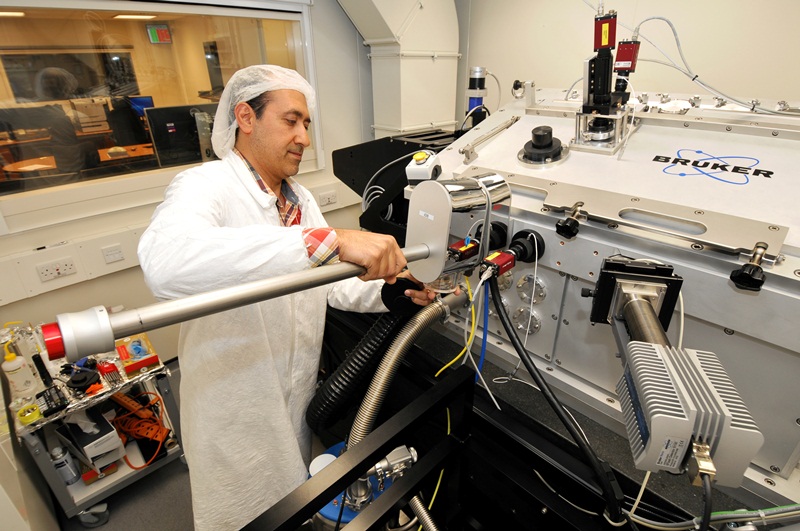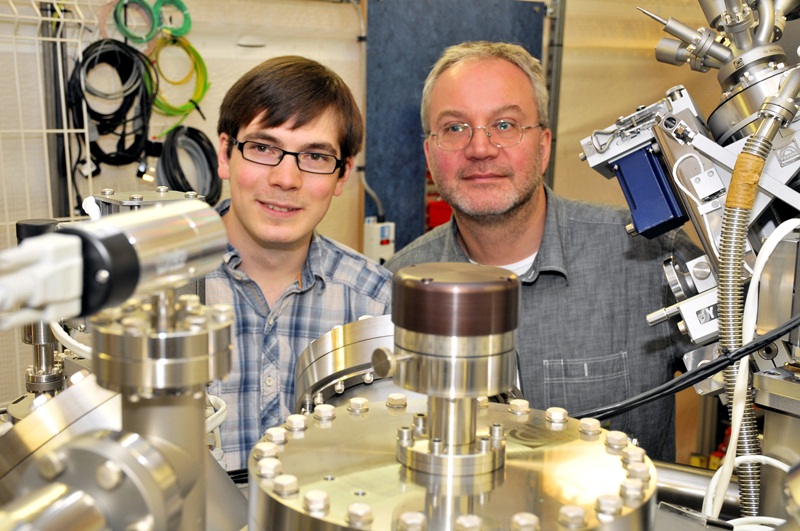Keep up to date with the latest research and developments from Diamond. Sign up for news on our scientific output, facility updates and plans for the future.
With three of the Phase III beamlines now taking users, the current total of operational beamlines at Diamond is 25. The remaining eight beamlines to be added are either in commissioning phase or under construction. All are due for completion by 2018 or earlier. An overview of their activities and progress can be found below.
| Beamline | PBS | Status | First User |
| I05 - Angle-Resolved Photoemission Spectroscopy (ARPES) | Moritz Hoesch | Operational | 2013 |
| B21 - High Automated Throughput SAXS (HATSAXS) | Robert Rambo | Operational | 2013 |
| I08 - Scanning X-ray Microscopy (SXM) | Burkhard Kaulich | Operational | 2014 |
| I23 - Long-Wavelength Macromolecular Crystallography | Armin Wagner | Commissioning | 2015 |
| B24 - Cryo-TXM | Liz Duke | Commissioning | 2015 |
| I15-1 XPDF | Heribert Wilhelm | Construction phase | 2016 |
| I14 - Hard X-ray Nanoprobe | Paul Quinn | Construction phase | 2017 |
| I21 - Resonant Inelastic Soft X-ray Scattering | Kejin Zhou | Construction phase | 2017 |
| B07 - Versatile Soft X-ray (VERSOX) | Georg Held | Construction phase, Endstation commissioned at I09 | 2017 |
| I02-1 - Versatile MX (VMXi) | Thomas Sorensen | Construction phase | 2017 |
| I02-2 - Versatile MX (VMXm) | Gwyndaf Evans | Construction phase |
Beamline I05 is a facility dedicated to the study of electronic structures by Angle-Resolved Photoemission Spectroscopy (ARPES). This technique is applied to materials with exotic electronic ground states such as unconventional superconductors, solids exhibiting charge and spin density waves, excitonic insulators and non Fermi liquids. I05 provides an intense and highly monochromatic beam of vacuum ultraviolet radiation to one of two end stations: the HR (high resolution)-ARPES branch, and the novel sub-micron resolution scanning photoemission microscope (nano-ARPES). Beamline I05 has produced many high quality publications since becoming fully operational this year.
Designed to complement Diamond’s Small-Angle X-ray scattering (SAXS) beamline (I22), B21 provides dedicated SAXS services for studies in liquid or solution. Liquid phase experiments are essential to understanding biology since all biologically relevant processes occur in a liquid environment, from the expression of genes to the interaction of enzymes. Thus, B21 is also complementary to X-ray crystallography and the forthcoming National Cryo-Electron Microscopy Facility at Diamond. First users were welcome in December 2013 and the beamline is now fully operational.
I08-SXM is the Scanning X-ray Microscopy (SXM) beamline for morphological, elemental and chemical speciation on a broad range of organic-inorganic interactions in a 250-4400 eV photon energy range, which is unique for an SXM facility. I08 has a range of applications including biological and biomedical science, earth and environmental science, geochemistry and materials science. The beamline allows scientists to gather information on the interaction of organic and inorganic matter under in situ conditions using novel X-ray imaging and spectromicroscopy techniques; meaning that it can be used to study the morphology, elemental distribution and chemical states on nanoscopic length scales. The beamline is now in optimisation phase following a successful first user visit ahead of schedule in July 2014.

Figure 1: Majid Kazemian Abyaneh, Senior Support Beamline Scientist working on I08.
The long-wavelength MX beamline I23 is a unique facility dedicated to directly solving the crystallographic phase problem from native proteins. It is radically different from the existing MX beamlines with an in vacuum sample environment and a large curved Pilatus 12M detector, bringing together cutting edge technology from different fields in science and engineering to realise this unique project. Researchers will be able to carry out research on DNA, RNA, native proteins and other building blocks of life. First diffraction data from inorganic samples and protein test crystals show the huge potential of this novel beamline. First users are expected in summer 2015.
B24 is a full-field transmission microscope designed specifically to meet the rising demand for tomographic imaging of biological specimens under near physiological conditions. The technique bridges the resolution gap that exists between electron microscopy and conventional light microscopy and allows acquisition of tomographic data from both native and fluorescent-labelled samples. B24 will enable scientists to study the internal structure of whole cells with the ability to see any changes associated with either a disease state or the effect of a drug treatment and in time it will be upgraded to receive Cat3 biological samples. The beamline is currently in commissioning phase and is expected to welcome its first user towards the end of 2015.
At over 185 m long, the Hard X-ray Nanoprobe beamline is designed to deliver nanoscale X-ray beams (<50 nm) for elemental, chemical and structural studies of a wide range of materials. Constructing a long beam requires optics hutches within the synchrotron building to condition the X-rays and an experimental end station housed in an external building to focus the beam and provide the experimental facilities needed to conduct nanoscale studies. The internal optics hutches are complete and first light took place in April 2015. The construction of the external building, which will house the Hard X-ray Nanoprobe beamline end station, support labs and new electron microscopy facilities, is now well underway with building completion due in winter 2015. First users are expected in spring 2017.
I21 is a dedicated Inelastic X-ray Scattering (IXS) facility that will produce highly monochromatised, focused and tunable X-ray beams. The beamline will be 81 m long, with its end station and spectrometer accommodated in an external building adjacent to the Diamond ring. The key research activity of the beamline focuses on condensed matter physics and material science. By studying the energy and momentum differences between the incident and the outgoing X-rays, users of I21 will be able to investigate the electronic, magnetic and lattice behaviour of novel materials of interest in both condensed matter physics and material science, in particular systems with strong electronic interactions and new functional materials such as Mott insulators, high-temperature superconductors, oxide heterostructures, catalysts, and carbon-based materials. First light is expected in February 2016 and I21 will welcome its first users in spring 2017.
XPDF will be applicable to a diverse range of disciplines such as materials chemistry, solid-state physics, Earth sciences and pharmaceuticals. Researchers will be able to study the local structure of crystalline, semi-crystalline and amorphous solids and liquids. The XPDF beamline is being built as a side-station to the I15 Extreme Conditions beamline. The design will allow both beamlines to operate concurrently. Synchronisation of hardware and PDF processing software will provide an unparalleled user-friendly PDF beamline. 2015 will see the commissioning of the monochromator, diagnostics and end station. XPDF is expecting to announce a first call for proposals in April 2016.
VERSOX will be a highly versatile soft X-ray beamline with two end stations; one for High Throughput (HT), and the other an Ambient Pressure (AP) end station that will jointly support a wide community of users. B07 will complement the range of experiments that can currently be undertaken by enabling spectroscopic measurements on samples held in non-vacuum environments. This will bring a deeper understanding to science areas such as catalysis, pharmaceuticals and biomaterials under realistic conditions or atmospheric chemistry. Construction of the beamline started in November 2014. Concurrently, one of the end stations is being constructed and commissioned on the soft X-ray branch of I09 to enable a fast transfer to B07 when available. First users on this end station are expected by the end of 2015.

Figure 2: Liam Deacon, Support Scientist, and Georg Held, Principal Beamline Scientist, on B07.
VMXi will be the first beamline of its kind solely dedicated to data collection directly from crystallisation experiments in situ – a new approach that MX beamlines at Diamond have pioneered over recent years. The new beamline will be highly automated and users will access beamline functionality remotely. It will enable direct diffraction analysis without any additional manipulation, and provide immediate feedback on crystal quality and parameters. With this insight, users can progress their crystallisation experiments in a more rational way. Building works for the new beamline is well underway and installation of the new beamline experimental station will start during the summer 2015. While the new beamline is being developed, the existing I02 continues to deliver beam for the MX user community.
VMXm will perform atomic structure determination in cases where the production of significant quantities of protein material and crystals is problematic. This is the case for many challenging protein complexes and medically important macromolecules that yield only very small crystals. The X-ray beam size on VMXm will be less than 0.5 microns and, with the use of novel X-ray optics and electron beam imaging methods, researchers will be able to precisely align the tiniest protein crystals into this X-ray beam, in vacuum, and measure X-ray diffraction data from them. In many ways VMXm will be a hybrid X-ray/cryoEM instrument making use of methods for sample preparation from cryo-electron-microscopy, imaging from scanning electron microscopy and diffraction data collection methods from X-ray crystallography. VMXm is currently under construction and is scheduled for first user operations towards the end of 2017.
Diamond Light Source is the UK's national synchrotron science facility, located at the Harwell Science and Innovation Campus in Oxfordshire.
Copyright © 2022 Diamond Light Source
Diamond Light Source Ltd
Diamond House
Harwell Science & Innovation Campus
Didcot
Oxfordshire
OX11 0DE
Diamond Light Source® and the Diamond logo are registered trademarks of Diamond Light Source Ltd
Registered in England and Wales at Diamond House, Harwell Science and Innovation Campus, Didcot, Oxfordshire, OX11 0DE, United Kingdom. Company number: 4375679. VAT number: 287 461 957. Economic Operators Registration and Identification (EORI) number: GB287461957003.